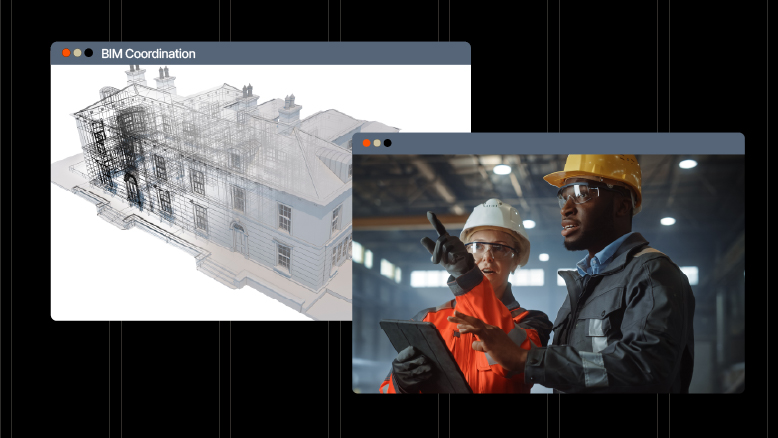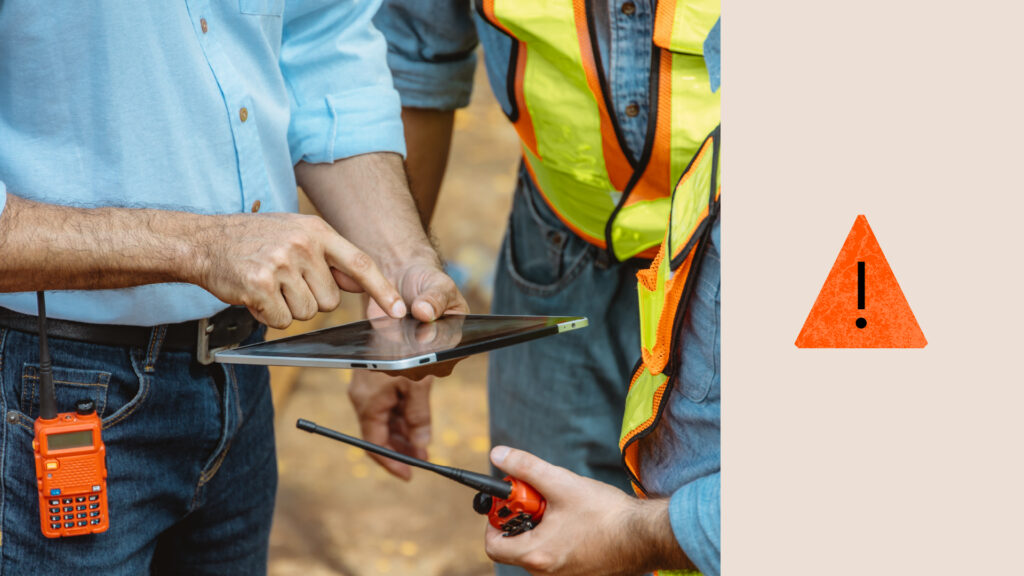— 8 min read
The Construction Tech Ecosystem: How Everything Fits Together
Last Updated Mar 21, 2025
Last Updated Mar 21, 2025

It’s tempting to jump to extremes when it comes to the new technology that seems to hit the market every day. When a product gets a lot of buzz, some people might immediately write it off while others might adopt it without any further consideration. Unfortunately, it’s rarely that easy. Success in construction isn’t about whether tech is part of the job, but rather, it’s about choosing the right tech and effectively integrating it into current business processes and with existing software platforms.
A tech stack is a project or company’s integrated collection of technologies to solve problems and create new possibilities. Building an effective ecosystem is a key to getting ahead in the construction industry and involves selecting and implementing technological solutions that align to a company’s business or performance objectives and optimize workflows.
This article explores the foundation of an effective tech ecosystem, considerations and examples for selecting software solutions and ways to overcome common challenges.
Table of contents
The Basics of Construction Tech Ecosystem
The foundation for most construction tech ecosystems is the tech stack, however, an ecosystem also includes other hardware and software solutions that integrate with the collection of existing tech and extend its impact into the field.
A company’s tech stack will often include software that can help complete and improve tasks, including:
- Preparing pay applications
- Collecting closeout documents
Hardware solutions might include equipment, such as robotics, and tools for data gathering, such as drones or cameras.
Building a tech ecosystem involves the selection and introduction of new tools and technologies as well as making sure tools are integrated with and complementing the rest of the ecosystem. Like any innovation, each tool should solve a problem or create new possibilities, and its implementation should include a process of establishing evaluation criteria, testing and demoing, creating an adoption plan and monitoring performance.
Building a Foundation: Core Software Solutions
Most tech ecosystems rely on a few, foundational software solutions that allow other parts of the ecosystem to be integrated to the whole and for necessary shareholders to have access to important tools and information.
In general, software solutions should be:
Scalable
Software should be adaptable and able to accommodate the needs of various project types and sizes. Similarly, they should be able to grow with companies as they expand.
Cloud-based
Cloud-based software makes it easier for stakeholders to access and use. Cloud-based applications also allow multiple stakeholders to collaborate in real-time, ensuring everyone has access to the most current data.
Configurable
Every project and company is different, and software should reflect that. When applicable, software should have dashboards that can be built to provide a customized selection of tools and information. For tools that collect and analyze data, reports should provide tailored insights based on key performance indicators (KPIs) and objectives.
Collaborative
Software should allow more people to contribute and access real-time information. This might include communication or messaging capacities and cloud-based access.
Automated
When possible, software should help automate repetitive tasks related to important workflows. This helps increase efficiency and reduce errors.
ERP Systems
A healthy, effective construction tech ecosystem must be built on a system that manages core business operations. For many companies, that’s an Enterprise Resource Planning System (ERP), which manages business operations, particularly finances.
An ERP should be comprehensive, offering detailed tracking and robust accounting features, including accounts payable and receivable, general ledger, costs including materials, labor and overheads, payroll and financial reporting, budgeting and forecasting.
The construction industry doesn’t have many ERPs that meet the industry’s unique needs. Procore has used its industry-specific knowledge to create tools for financial planning and budget management that are practical and can be integrated with other workflows and project management tools.
Project Management Software
Project Management Information Systems (PMIS) are the backbone of a construction tech ecosystem. This should centralize important information such as documents, scheduling tools, Requests for Information (RFIs), drawings, daily logs and change orders. Having a single place to find all project-related data and documents should increase visibility and ease of access for necessary stakeholders.
A PMIS should be able to integrate or work directly with other important elements of the tech ecosystem, such as the ERP, customer management tools or BIM software. For example, time tracking, resource management, budget tracking and change order management are all things that can be initiated on a PMIS but need to be integrated and tracked on the ERP as well.
Estimating & Preconstruction Software
Estimating and preconstruction software should help facilitate collaboration and estimation that leads to the best possible decision-making. These tools should integrate with a variety of databases to provide accurate and detailed cost estimations for materials, labor and equipment. They should also help anticipate and mitigate potential risks by incorporating contingencies, risk factors and automating important processes such as takeoffs.
BIM (Building Information Modeling)
Building Information Modeling (BIM) helps create virtual models of structures and revise them to reduce rework and costs on the actual project. BIM solutions drive constructability, guide business decisions and integrate seamlessly with project management systems like Procore. BIM tools often have comprehensive modeling capabilities, including 3D capabilities to create detailed and accurate digital representations of physical structures, 4D for time and scheduling and 5D for cost estimation.
Emerging Tools and Technologies
A solid foundation of software solutions creates more plentiful and accurate data that can help identify and select tools and technologies to expand the impact of the tech ecosystem.
Drones, Wearables and Robotics
Hardware solutions are currently used mostly to enhance or assist with the work already being done on a jobsite. There are a growing number of types of robotics that can complete specific tasks on a jobsite that would otherwise take a long time to complete, require a high level of precision or are dangerous. Drones and wearables are becoming increasingly commonplace as ways to gather data and monitor safety and efficiency.
AI and Machine Learning
The uses for artificial intelligence and machine learning are expanding all the time. They can be deployed across various areas of an organization and programmed to address challenges or improve processes on projects, such as material procurement, optimizing team performance, financial forecasting and monitoring, risk management and identifying potential safety hazards.
The effectiveness of AI is highly dependent on the quality of data it’s able to access and analyze, so it’s important that the tech stack is designed to integrate with AI and provide it with accurate and comprehensive information, such as keeping track of materials inventory.
IoT (Internet of Things)
Internet of Things, or IoT devices connect various construction systems for real-time data and monitoring, enhancing the ability to monitor and optimize efficiency and safety. For example, there are tools that track worker movements and equipment usage on-site, which provides data that can be used to improve operational efficiency, streamline operations and maximize safety.
Augmented and Virtual Reality
AR and VR are being used for design visualization, training and safety simulations. These technologies are still far from being ready for widespread adoption but they already demonstrate the potential to transform planning and execution in controlled settings.
Stay updated on what’s happening in construction.
Subscribe to Blueprint, Procore’s free construction newsletter, to get content from industry experts delivered straight to your inbox.

Adoption and Implementation: Best Practices
Creating a tech ecosystem requires thoughtful and informed decision-making and can come with real challenges.
Address resistance to adoption.
People can be resistant when they’re being forced to implement tools they don’t understand, don’t see the use in or fear could put them out of work. One of the best ways to handle this is through open communication. Taking time to listen to concerns, address them directly and explain why an innovation is being adopted can help people get invested and can often maximize the tech’s impact by enlisting their expertise. Some tools, such as Procore, offer training and support to help with adoption and effective integration.
Have a clear, defined purpose.
Successful implementation requires understanding an organization’s business needs and goals. Data and input from potentially impacted stakeholders can help ensure tools are aligned with the long-term vision and provide high impact ways to solve problems or create new possibilities.
Take a phased approach.
Going immediately all-in on a new technology is rarely effective and can often lead to the premature conclusion that the tech isn’t effective or helpful. Adoption should ideally happen in phases that allow for better identifying any issues and effectively addressing them. Often, adoption will start with identifying specific problems, collecting data, a demo period when possible, a rollout period that might include training and supervised usage and then consistent monitoring. Business analysts and specialized technologists can provide guidance and assistance throughout most phases.
Keeping Up and Moving Towards a Holistic Tech Ecosystem
The construction tech landscape is constantly changing. Technologies regularly require updates, training and support. Problems are always changing based on the project, stakeholder needs and the market. Take time to collect and analyze all types of data, including information on performance, news on the industry and input from stakeholders. This can help keep an ecosystem up-to-date and as useful as possible.
Over time, building a well-integrated tech ecosystem should create powerful ways to increase efficacy, decrease risk and improve business development. But It doesn’t happen overnight. Each element should be carefully considered and implemented, as every tech ecosystem should be unique to the company and stakeholders using it. Effective ecosystems are aligned towards company goals, designed to address specific problems and should be a valuable way to become more competitive in a fast-moving industry.
Was this article helpful?
Thank you for your submission.
100%
0%
You voted that this article was . Was this a mistake? If so, change your vote here.
Scroll less, learn more about construction.
Subscribe to The Blueprint, Procore’s construction newsletter, to get content from industry experts delivered straight to your inbox.
By clicking this button, you agree to our Privacy Notice and Terms of Service.
Categories:
Tags:
Written by
Jeff Sample
10 articles
Jeff Sample has devoted the past 25+ years to transforming companies. Jeff optimizes companies throughout the construction industry by designing solutions, optimizing strategic advantages, and breaking down information silos. His passion for outdoor adventure and Ironman competitions garnered him the moniker, "The Ironman of IT." As an Industry Evangelist, Jeff promotes collaboration and the transformation of construction to help project teams reach their potential. His depth of IT experience in various industries and his passion for continuous improvement have made Jeff a popular speaker and vocal thought leader in construction, spending much of his time educating on multiple topics to better the industry.
View profileJames Hamilton
70 articles
James Hamilton is a writer based in Brooklyn, New York with experience in television, documentaries, journalism, comedy, and podcasts. His work has been featured on VICE TV and on The Moth. James was a writer and narrator for the show, VICE News Tonight, where he won an Emmy Award and was nominated for a Peabody Award.
View profileExplore more helpful resources

Streamlining Construction Projects with Effective BIM Coordination
The old saying goes: if you fail to plan, you plan to fail. Construction professionals know this better than nearly anyone. To take a project from a vision in an owner’s...

Construction Invoice Factoring: A Quick Guide
Construction companies need to maintain consistent cash flow. Projects can take years to complete, and delays and unforeseen events may keep expenses mounting. Adding to this load are typically high upfront...

Understanding Subcontractor Bid Packages in Construction
Construction bid packages can have a cascading impact on the success of a construction project. The quality of a bid project may affect the quality of the bids, which in...

Tackling the Top 10 Construction Industry Issues
The construction industry is constantly evolving, bringing both opportunities and challenges. Companies must navigate an array of construction industry issues — from workforce shortages to integrating new technologies into their...